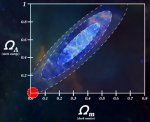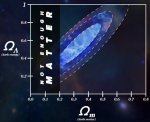https://www.sciencedaily.com/releases/2017/03/170330115254.htm So for observational purposes nothing has changed .
You are using an out of date browser. It may not display this or other websites correctly.
You should upgrade or use an alternative browser.
You should upgrade or use an alternative browser.
Astronomy / Space Astronomers no longer in the Dark about Dark energy
- Thread starter starman
- Start date
Coupled with Erik Verlinde's proposed Emergent Gravity, we could do away with the handwavium that is behind "Dark Matter" and "Dark Energy".
https://phys.org/news/2016-11-theory-gravity-dark.html
https://darkmatterdarkenergy.com/2016/12/30/emergent-gravity-verlindes-proposal/
[where is it]
https://phys.org/news/2016-11-theory-gravity-dark.html
https://darkmatterdarkenergy.com/2016/12/30/emergent-gravity-verlindes-proposal/
[where is it]
https://www.sciencedaily.com/releases/2017/03/170330115254.htm So for observational purposes nothing has changed .
Notwithstanding a PM, I should point out that the fact that doubt had been cast upon the evidence in support of dark energy (even though it had produced Nobel Prizes in 2011 {and further prizes}) in work reported in October last year (2016) following a re-analysis of the (enlarged) dataset that had been the basis of the hypothesis.
Details here:
https://phys.org/news/2016-10-universe-rateor.html
(I thought I had posted about it on here before but it seems I had not, or at least I can't find it.)
I hope that the OP will not object to me again providing input in this subject area, which of course they may not agree with, but it is related academic material.
Notwithstanding a PM, I should point out that the fact that doubt had been cast upon the evidence in support of dark energy (even though it had produced Nobel Prizes in 2011 {and further prizes}) in work reported in October last year (2016) following a re-analysis of the (enlarged) dataset that had been the basis of the hypothesis.
Details here:
https://phys.org/news/2016-10-universe-rateor.html
(I thought I had posted about it on here before but it seems I had not, or at least I can't find it.)
I hope that the OP will not object to me again providing input in this subject area, which of course they may not agree with, but it is related academic material.
- The article you linked from 2016 claims there is no accelerating expansion of the universe, that it has been expanding at a constant rate. This is completely different from the article linked by the OP, which acknowledges the accelerating expansion of the universe (just by a different mechanism than dark energy).
- Despite the much larger data set, the study you linked is consistent with that done in the 1990s. Both only had at most 3 sigma significance for an expanding universe. The thing is that the evidence for an accelerating universe isn't solely based on Type Ia data. Taking other observations into account (amount of matter in the universe, the flatness of the universe, and baryon acoustic oscillations), increases the certainty well above 5 sigma.
The amount of matter in the universe we observe completely rules out the region of the Type Ia analysis that yields a non-expanding universe. This is why the 1990s study was taken so seriously.
Last edited:
- The article you linked from 2016 claims there is no accelerating expansion of the universe, that it has been expanding at a constant rate. This is completely different from the article linked by the OP, which acknowledges the accelerating expansion of the universe (just by a different mechanism than dark energy).
- Despite the much larger data set, the study you linked is consistent with that done in the 1990s. Both only had at most 3 sigma significance for an expanding universe. The thing is that the evidence for an accelerating universe isn't solely based on Type Ia data. Taking other observations into account (amount of matter in the universe, the flatness of the universe, and baryon acoustic oscillations), increases the certainty well above 5 sigma.
The amount of matter in the universe we observe completely rules out the region of the Type Ia analysis that yields a non-expanding universe. This is why the 1990s study was taken so seriously.
1. Yeah, I did write "doubt had been cast upon the evidence in support of dark energy", not in respect of the OP's linked report but a separate prior report coming from a different study. In essence, just saying that it isn't just the OP's link that casts doubt towards the existence of dark energy. I probably should have made it clearer that it was not directly related nor either in support or contrary to the OP's link.
2. I don't think your statement is precisely correct. The point, as I understand it, of the re-examination result is that the sigma was reduced and reportedly supported a non-accelerating rate of expansion, there was no mention of the universe being steady-state, just that it indicated towards a constant rate of expansion.
The issue at hand is the challenging of current "standard model" cosmology, hence my posting of two separate but related matters.
My maths is certainly not up to that required for this subject. I am not offering any authority since I am no astronomer or theoretical physicist (retired engineer) just an interested layman. So I am making my remarks and posting information that I have taken from academic papers or reports and analyses of them. I welcome any informed comment on the matters in hand.
Last edited:
This is the 3-sigma result from the Type Ia data (I know the x-axis says "dark matter", but it really means all matter). The contours indicate relative probability, increasing as you get closer to the center. It shows that there is a possibility (albeit lower) that there is no accelerating universe. However, that combination results in almost no matter in the universe either.2. I don't think your statement is precisely correct. The point, as I understand it, of the re-examination result is that the sigma was reduced and reportedly supported a non-accelerating rate of expansion, there was no mention of the universe being steady-state, just that it indicated towards a constant rate of expansion.
The issue at hand is the challenging of current "standard model" cosmology, hence my posting of two separate but related matters.
My maths is certainly not up to that required for this subject. I am not offering any authority since I am no astronomer or theoretical physicist (retired engineer) just an interested layman. So I am making my remarks and posting information that I have taken from academic papers or reports and analyses of them. I welcome any informed comment on the matters in hand.
Taking into account the amount of matter in the universe we observe, we can eliminate anything lower than 0.2 on the x-axis. This also eliminates the possibility for a non-accelerating universe.
As best we can measure, the universe is flat. That is the line going diagonally down across the graph. Using the CMB to measure the flatness of the universe yields the diagonal colored band (including probability contours). The overlap of the CMB and the Type Ia data gives greater than 5-sigma significance to the acceleration of the universe. This is the same kind of analysis that was done to the 1990s Type Ia data to make the accelerating universe the "standard model".
Last edited:
This is the 3-sigma result from the Type Ia data (I know the x-axis says "dark matter", but it really means all matter).
....................
This is the same kind of analysis that was done to the 1990s Type Ia data to make the accelerating universe the "standard model".
...................
OK -Thanks for that, I'll defer to your interpretation as my stats just isn't good enough. (The Higg's Boson course from Edinburgh University {online thing} showed me how poor my stats were!)
Why then was the October 2016 paper I referred to given so much credence? Or has there been retraction that I have not seen reported?
Last edited:
There's nothing wrong with the data, it has a much larger sample size than 1990s study. It was more that the media sensationalized the research. It's way more dramatic to report that the "standard model" might have been overturned.Why then was the October 2016 paper I referred to given so much credence? Or has there been retraction that I have not seen reported?
Last edited:



